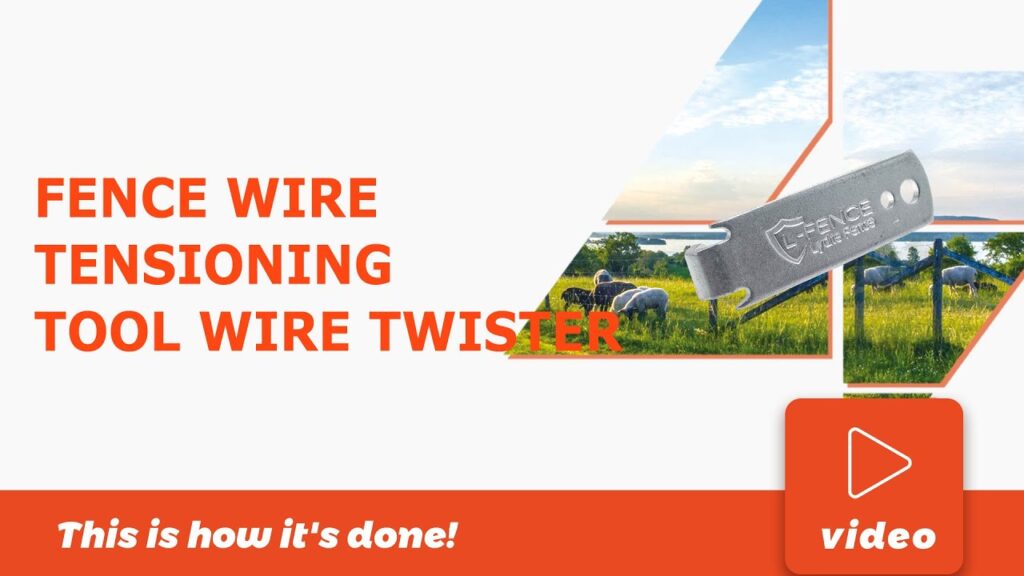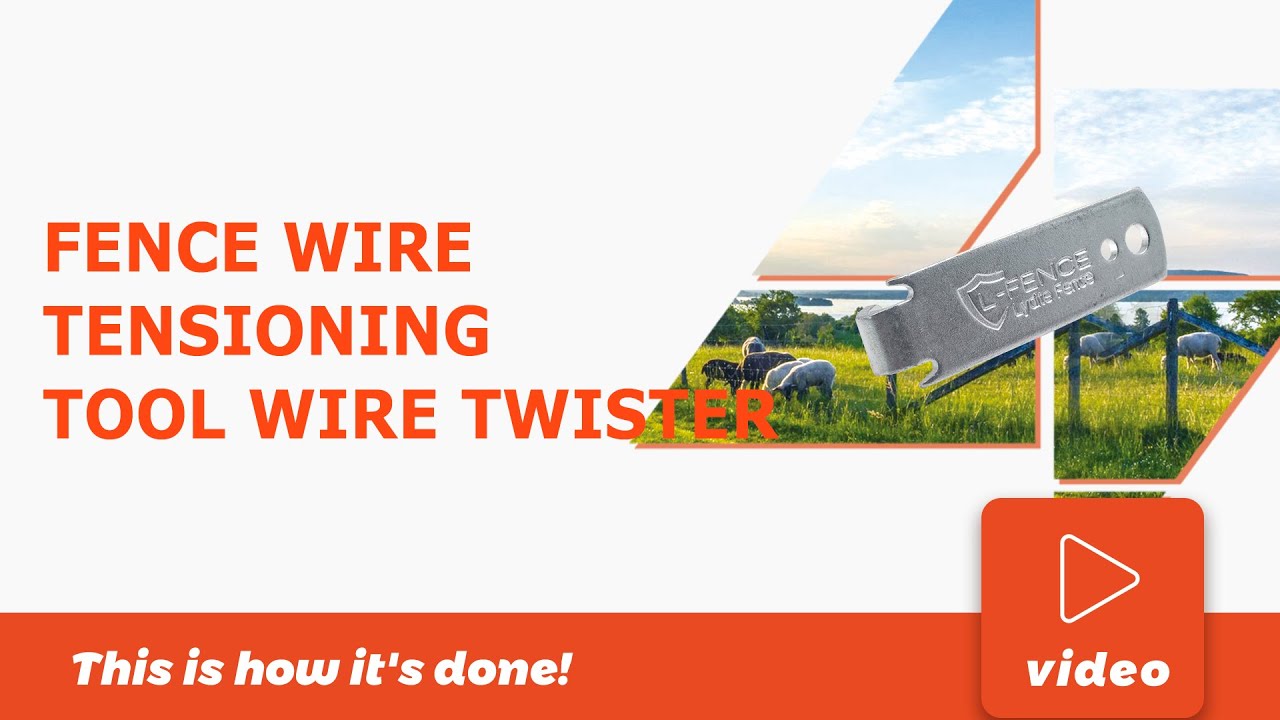
Mastering Fence Repair: The Essential Guide to Fence Wire Twisting Tools
Maintaining a secure and functional fence is crucial for property owners, whether for agricultural purposes, livestock containment, or simply defining property lines. One essential tool in any fence maintenance arsenal is the fence wire twisting tool. This seemingly simple device can significantly streamline the process of repairing and tightening fence wires, saving time and effort while ensuring a robust and long-lasting fence. This article will delve into the world of fence wire twisting tools, exploring their types, benefits, proper usage, and factors to consider when selecting the right one for your needs.
Understanding the Importance of a Good Fence
Before diving into the specifics of fence wire twisting tools, it’s important to understand why maintaining a good fence is so vital. Fences serve numerous purposes, including:
- Security: A well-maintained fence deters trespassers and protects property from unauthorized access.
- Containment: For agricultural properties, fences are essential for keeping livestock safely enclosed and preventing them from wandering onto roads or neighboring land.
- Property Definition: Fences clearly mark property boundaries, preventing disputes and ensuring clarity.
- Aesthetics: A well-kept fence can enhance the overall appearance of a property, adding to its curb appeal.
Damaged or sagging fence wires compromise these functions, making regular maintenance essential. This is where the fence wire twisting tool comes into play.
What is a Fence Wire Twisting Tool?
A fence wire twisting tool, also known as a wire stretcher or wire tightener, is a hand-operated device designed to grip and twist two ends of wire together, creating a secure and tight splice. These tools are specifically designed to handle the high tensile strength of fence wire, making repairs easier and more efficient than using pliers or other makeshift methods. They are a crucial component for anyone involved in fence construction or maintenance.
Types of Fence Wire Twisting Tools
While the basic function remains the same, fence wire twisting tools come in various designs, each with its own advantages and disadvantages. Some common types include:
Inline Wire Twisters
These tools are designed to be placed directly in line with the fence wire. They typically feature a handle that, when rotated, twists the wire ends together. Inline twisters are often compact and easy to use, making them a popular choice for smaller repairs.
Offset Wire Twisters
Offset twisters have a handle that is positioned to the side of the wire, providing more leverage and allowing for easier twisting, especially when working with thicker or more tightly stretched wires. These are a good choice for larger projects or for individuals who need more power.
Ratchet Wire Twisters
Ratchet wire twisters incorporate a ratcheting mechanism that allows the user to apply tension gradually and consistently. This is particularly useful for achieving a very tight and secure splice. The ratcheting action reduces the strain on the user’s hands and arms, making them ideal for larger jobs.
Chain Wire Twisters
Chain wire twisters utilize a chain and hook system to grip the wires. The user pulls the chain to tighten the wire, and a locking mechanism holds the tension. These tools are often used for heavier-duty applications and can handle a wide range of wire gauges. A good fence wire twisting tool of this type is invaluable.
Benefits of Using a Fence Wire Twisting Tool
Investing in a quality fence wire twisting tool offers numerous benefits over attempting to repair fences without one:
- Increased Efficiency: These tools significantly speed up the repair process, allowing you to fix fences quickly and efficiently.
- Improved Security: A properly twisted wire splice is much stronger and more secure than a makeshift repair, ensuring the integrity of your fence.
- Reduced Effort: Fence wire twisting tools provide leverage and grip, reducing the amount of physical effort required to tighten wires.
- Professional Results: Using the right tool allows you to achieve a clean, professional-looking repair.
- Safety: These tools are designed to handle the tension of fence wire, reducing the risk of injury.
How to Use a Fence Wire Twisting Tool
While the specific steps may vary slightly depending on the type of tool, the general process for using a fence wire twisting tool is as follows:
- Prepare the Wire: Cut the damaged section of wire and overlap the ends of the new and existing wire by several inches.
- Attach the Tool: Securely attach the fence wire twisting tool to both ends of the overlapping wire. Ensure a firm grip to prevent slippage.
- Twist the Wire: Rotate the handle or pull the chain (depending on the tool type) to twist the wire ends together. Apply steady pressure and avoid over-twisting, which can weaken the wire.
- Secure the Splice: Once the wire is sufficiently tight, release the tool and trim any excess wire ends.
- Inspect the Repair: Check the splice to ensure it is secure and that the wire is properly tensioned.
Factors to Consider When Choosing a Fence Wire Twisting Tool
Selecting the right fence wire twisting tool for your needs requires careful consideration of several factors:
Wire Gauge
Different tools are designed to handle different wire gauges. Make sure the tool you choose is compatible with the type of wire used in your fence. Some tools are designed for lighter gauge wire, while others are built for heavy-duty applications.
Durability
Look for a tool made from high-quality materials that can withstand the rigors of regular use. A durable tool will last longer and provide more reliable performance. Consider tools made from hardened steel or other robust materials.
Ease of Use
Choose a tool that is comfortable to hold and easy to operate. Ergonomic handles and intuitive designs can significantly reduce fatigue, especially during larger projects. A fence wire twisting tool should feel natural in your hand.
Leverage
Consider the amount of leverage the tool provides. A tool with good leverage will make it easier to tighten the wire, especially when working with thicker gauges or tightly stretched wires. Offset and ratchet twisters often provide superior leverage.
Price
Fence wire twisting tools range in price from relatively inexpensive to more premium options. Consider your budget and the frequency with which you anticipate using the tool. A higher-priced tool may be worth the investment if you plan to use it frequently or for heavy-duty applications. Researching online and reading reviews can help you find a balance between price and quality. [See also: Best Fencing Practices for Livestock]
Maintaining Your Fence Wire Twisting Tool
Proper maintenance will extend the life of your fence wire twisting tool and ensure its continued performance. Here are some tips:
- Clean the Tool: After each use, clean the tool with a brush or cloth to remove dirt, debris, and rust.
- Lubricate Moving Parts: Regularly lubricate the moving parts of the tool with a light oil to prevent corrosion and ensure smooth operation.
- Store Properly: Store the tool in a dry place to prevent rust and corrosion.
- Inspect for Damage: Regularly inspect the tool for signs of damage, such as cracks, bends, or worn parts. Replace any damaged parts promptly.
Common Mistakes to Avoid
To ensure a successful and safe fence repair, avoid these common mistakes:
- Over-Twisting the Wire: Over-twisting can weaken the wire and make it more prone to breakage. Apply steady pressure and avoid twisting beyond the point where the wire is tight.
- Using the Wrong Tool: Using a tool that is not designed for the specific wire gauge or application can damage the tool and compromise the repair.
- Neglecting Safety Precautions: Always wear appropriate safety gear, such as gloves and eye protection, when working with fence wire.
- Ignoring Wire Tension: Failing to properly tension the wire can result in a sagging fence that is not secure.
Conclusion
A fence wire twisting tool is an indispensable tool for anyone involved in fence maintenance or construction. By understanding the different types of tools available, their benefits, and how to use them properly, you can ensure that your fences remain secure, functional, and aesthetically pleasing for years to come. Investing in a quality tool and following proper maintenance practices will save you time, effort, and money in the long run. Whether you’re a seasoned farmer, a property owner looking to maintain your boundaries, or a professional fencing contractor, mastering the art of using a fence wire twisting tool is a skill that will serve you well. The right fence wire twisting tool will become a trusted part of your toolkit. Remember to always prioritize safety and choose the right tool for the job. A well-maintained fence is a testament to good stewardship and attention to detail, and the fence wire twisting tool is your key to achieving that goal. Consider the type of fence wire twisting tool that best fits your needs. [See also: Different Types of Fencing Materials]

